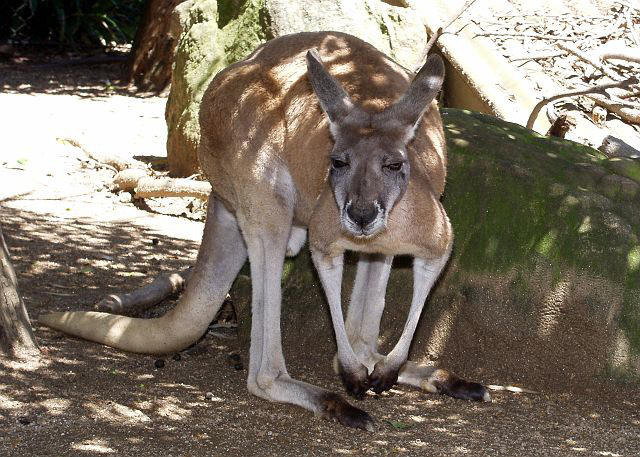|
|
|
|
The Red Kangaroo (Macropus rufus) is the largest marsupial in the world. It is native to Australia, particularly in the dry grasslands that cover the continent. Red Kangaroos are in the macropodidae family which means "large footed," rightly so since the animal has large feet with long tendons that helps it propel its body when it is hopping from predators, toward shelter, or foraging for food. Although this species is named the Red Kangaroo, colors are variable among the sexes. Males, also known as "bucks", "old men" or "boomers", can grow to be 80 to 90kg and usually have reddish-brown fur. Females, who grow to be only 40 kg, are usually a grayish-blue color and are nicknamed "blue fliers." Kangaroos travel in various sized packs called "mobs" and the young are called "joeys." A mob usually consists of one dominant male, many adult females, and joeys of both sexes. All kangaroos are classified as marsupials because they have pouches located in the anterior portion of their bodies that function as "holders" for their young. These pouches serve to provide a space for continual growth for the joey as well as protection from predators and dry conditions. Red Kangaroos can live as long as thirty years if they can make it past their first year of life in harsh, dry conditions. Kangaroos also have a unique mechanism for locomotion. Instead of walking and running on quadruped, kangaroos stand up on two feet and use their long tails as a driving force to help them hop from place to place. This mechanism of locomotion is extremely efficient and allows them to reach speeds of up to 40 miles per hour, jump distances of 29 feet and heights of 6 feet. A Red Kangaroo can be differentiated from other species by its naked nose, black and white patches on each side of its muzzle and a white stripe that starts at the nose and continues to the ear. Some would argue that the Red Kangaroo is the most striking of all kangaroo species because of its powerful build and graceful movement. I find the Red Kangaroo to be an extremely interesting species, mainly due to its relatively isolated habitat. People who do not live in or visit areas where this species exists will most often never see one in the wild. Since the Red Kangaroo is a marsupial, its means of reproduction are fascinating and much different from the placental mammals that are native to North America. I found it both interesting and fun to research and create a site dedicated to the Red Kangaroo. As a self-proclaimed world traveler, I have had the privilege of seeing kangaroos in the wild and in captivity and when speaking with a few Australians, found out that kangaroos are loved except when they try to cross the highways in front of a car! However, Kangaroos are easily recognized by people of all ages and nationalities for being such a unique and memorable species and I felt it only right to create a webpage to further educate those interested in the Red Kangaroo.
This website was created for Organismal Biology (BIO 203) at the University of Wisconsin-La Crosse on 4.26.07 This page is created by Kelly Michaels michaels.kell@students.uwlax.edu
|
|



